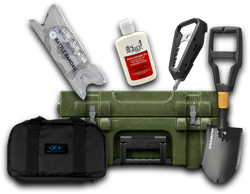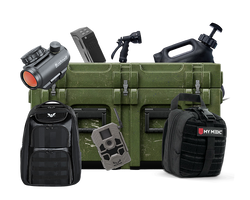
Bug out Bag vs. Get Home Bag Essentials
Having the right type of bag when packing for survival situations is vital. While you look for the right type of bags, you will come across 2 main types named bug out bags and get home bags. Each of these has different use cases with varying specifications.
What is a Bug Out Bag?
Bug out bags are the bags you must take when leaving the place. These generally hold much more stuff inside, so they also weigh more. Typically, this bag holds around 40 pounds or 15 KGs of stuff inside, which may be sufficient for 1 week of survival time.
What is a Get Home Bag?
Get home bags are the bags you can take with you to deal with a few hours of survival situations, knowing that you will return with your bag. As it is made only to help you survive for a few hours, it contains much less stuff, is lightweight by almost half, and is easier to carry.
Bug out Bag vs. Get Home Bag Essentials
You may pack both bags depending on your requirements when packing your survival stuff. However, due to different applications, the material and amount will differ in both cases.
1. Food
In the Bug out Bag
As you are packing for a week of survival, you may include food that requires cooking, but it must be quick to eat and lightweight enough to carry. Noodles, peanut butter, rice, and crackers make good options here.
In the Get Home Bag
You must keep the quickest and easiest food items in your get-home bag. You only want to survive for a few hours, so carrying energy bars, biscuits, and other snacks will be a great choice. Please carry an MRE along.
2. Water
In the Bug out Bag
Add a personal water filter in this bag and a 1-liter bottle of clean water. Keeping water in a stainless steel bottle is a good idea, especially because it helps better deal with different weather situations.
In the Get Home Bag
There is no need to carry gallons of water on your back as you only need to carry a small bottle of water. However, carrying a pocket filter that can be used anywhere to purify water will be great.
3. First Aid
In the Bug out Bag
Include a larger first aid kit containing medication for wounds and stitches in this bag. Carrying anti-diarrhea medications and an EPI pen will be a good idea. Also, carry a few painkillers to keep you going even on the harshest days.
In the Get Home Bag
A small first aid kit works fine with the get home bag. Carrying band-aids, antibiotic creams, aspirin, and sunscreen is a great idea. As you will not be away from home for a very long time, you will not need to carry medication for severe cases until necessary.
4. Clothing
In the Bug out Bag
Add duplicate clothes, including warm socks, a hat, and gloves. Apart from these, adding hiking boots will be good.
In the Get Home Bag
Carrying an extra pair of socks will be awesome for this bag. Apart from socks, you may not need anything else; however, carrying some extra shoes (preferably waterproof ones) will still be a good idea.
5. Protection
In the Bug out Bag
Keep a protective knife along with an axe for added security. Carrying a pistol and some extra ammo will help in both protection and hunting. Lastly, it is good to carry some masks for each family member.
In the Get Home Bag
You can start with a survival knife, as it will protect you from most humans and animals. However, if your locality allows you to carry a gun with ammo for protection, it is good to carry one.
6. Shelter
In the Bug out Bag
Find yourself a small popup tent that offers an instant setup experience. Along with the tent, include some paracord, a plastic trap, and emergency blankets to deal with every emergency nature throws at you.
In the Get Home Bag
As you are only trying to make it for a few hours before you get back to your home, keeping an emergency blanket will be more than enough for the get home bags. You may also carry a foldable umbrella to stay safe from rain, but that is not necessary.
7. Documents
In the Bug out Bag
Here you want to carry all the important documents. These are not only important for keeping safe, but these documents can also be helpful for official help during chaotic circumstances.
In the Get Home Bag
Keep a photo of all your family members or people with whom you live. Include a list of contacts physically written because if your smartphone fails, you will have a physical copy of important contacts.
8. Communication
In the Bug out Bag
Keep a cell phone along with radio walkie-talkies. Have some solar-powered charging solution ready, or get a hand-cranked charger, so you are never left out with no power.
In the Get Home Bag
An old mobile phone with a fully charged battery is essential. It does not need to be a smartphone, as you only want it to dial 911 in an emergency. Carry a power bank with that phone so it never runs out of juice.
9. Other stuff
In the Bug out Bag
Always keep a headlamp along with a good quality multi-tool. Some duct tape and a folding shovel will also be good in survival situations.
In the Get Home Bag
If you still have space left in your bag, keeping a flashlight with a Swiss army knife and some eye protection glasses will be insightful.
Note:
You may need some additional stuff, and it is good to carry everything you need. Just be sure that you are not adding any unnecessary stuff.
Conclusion
Each of these bag types has its pros and cons. For instance, if one holds more survival stuff, the other is easier to carry. Note that carrying the wrong bag will make you extremely inefficient in a survival situation. So, your best choice will be to stay ready to deal with any challenge.
Image by Aliko Sunawang from Pixabay
Share this article








